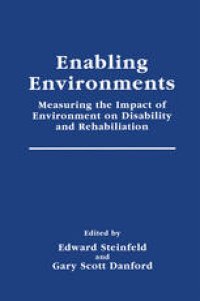
Ebook: Enabling Environments: Measuring the Impact of Environment on Disability and Rehabilitation
- Tags: Community and Environmental Psychology, Health Psychology, Architecture general, Environmental Management
- Series: Plenum Series in Rehabilitation and Health
- Year: 1999
- Publisher: Springer US
- Edition: 1
- Language: English
- pdf
TItis volume is the first effort to compile representative work in the emerging research area on the relationship of disability and physical environment since Barrier-Free Environments, edited by Michael Bednar, was published in 1977. Since that time, disability rights legislation like the Americans, with Disabilities Act in the United States, the worldwide growth of the independent-living move ment, rapid deinstitutionalization, and the maturation of functional assessment methodology have all had their impact on this research area. The impact has been most noticeable in two ways-fostering the integration of environmental vari ables in rehabilitation research and practice, and changing paradigms for environ mental interventions. As the contributions in this volume demonstrate, the relationship of disabil ity and physical environment is no longer of interest primarily to designers and other professionals concerned with managing the resources of the built environ ment. The physical environment has always been recognized as an important variable affecting rehabilitation outcome. Until recently, however, concepts and tools were not available to measure its impact in clinical practic~ and outcomes research. In particular, lack of a theoretical foundation that integrated environ ment with the disablement process hampered development of both research and clinical methodology. Thus, the physical environment received little attention from the mainstream rehabilitation research community. However, this situation is changing rapidly.
This collection focuses on methods for measuring the role of the physical environment in the disablement process and the limitations of current theory, knowledge, and research in the field. Linking the chapters is a new paradigm of research on accessibility, which emphasizes that disability is both a social and an individual process and is consistent with recent developments in a disability rights, rehabilitation practice, and environmental design.
This collection focuses on methods for measuring the role of the physical environment in the disablement process and the limitations of current theory, knowledge, and research in the field. Linking the chapters is a new paradigm of research on accessibility, which emphasizes that disability is both a social and an individual process and is consistent with recent developments in a disability rights, rehabilitation practice, and environmental design.
Content:
Front Matter....Pages i-xvii
Introduction....Pages 1-6
Front Matter....Pages 7-9
Theory as a Basis for Research on Enabling Environments....Pages 11-33
Research Implications of Universal Design....Pages 35-57
Space Requirements for Accessibility....Pages 59-88
Front Matter....Pages 89-91
“The Enabler” Applied to Occupational Therapy....Pages 93-109
Measuring the Influences of Physical Environments on the Behaviors of People with Impairments....Pages 111-137
Measuring Constraints to Inhabitant Activities....Pages 139-164
Assessing Special Care Units for Dementia....Pages 165-181
Using Environmental Simulation to Test the Validity of Code Requirements....Pages 183-206
Front Matter....Pages 207-210
A Day’s Journey Through Life©....Pages 211-231
Detection and Discrimination of Tactile Warning Signals in Field Conditions....Pages 233-250
Stigma and Architecture....Pages 251-270
Evaluating Models and Measures of Environmental Performance....Pages 271-294
Front Matter....Pages 295-296
Computer Simulation of Cane Techniques Used by People with Visual Impairments for Accessibility Analysis....Pages 297-317
Evaluating Accessibility through Computer-Aided Design....Pages 319-330
Wayfinding Performance by People with Visual Impairments....Pages 331-349
Postoccupancy Evaluation of Universally Accessible Multifamily Housing Units....Pages 351-371
Selecting Person— Environment Assessments....Pages 373-400
Back Matter....Pages 401-418
This collection focuses on methods for measuring the role of the physical environment in the disablement process and the limitations of current theory, knowledge, and research in the field. Linking the chapters is a new paradigm of research on accessibility, which emphasizes that disability is both a social and an individual process and is consistent with recent developments in a disability rights, rehabilitation practice, and environmental design.
Content:
Front Matter....Pages i-xvii
Introduction....Pages 1-6
Front Matter....Pages 7-9
Theory as a Basis for Research on Enabling Environments....Pages 11-33
Research Implications of Universal Design....Pages 35-57
Space Requirements for Accessibility....Pages 59-88
Front Matter....Pages 89-91
“The Enabler” Applied to Occupational Therapy....Pages 93-109
Measuring the Influences of Physical Environments on the Behaviors of People with Impairments....Pages 111-137
Measuring Constraints to Inhabitant Activities....Pages 139-164
Assessing Special Care Units for Dementia....Pages 165-181
Using Environmental Simulation to Test the Validity of Code Requirements....Pages 183-206
Front Matter....Pages 207-210
A Day’s Journey Through Life©....Pages 211-231
Detection and Discrimination of Tactile Warning Signals in Field Conditions....Pages 233-250
Stigma and Architecture....Pages 251-270
Evaluating Models and Measures of Environmental Performance....Pages 271-294
Front Matter....Pages 295-296
Computer Simulation of Cane Techniques Used by People with Visual Impairments for Accessibility Analysis....Pages 297-317
Evaluating Accessibility through Computer-Aided Design....Pages 319-330
Wayfinding Performance by People with Visual Impairments....Pages 331-349
Postoccupancy Evaluation of Universally Accessible Multifamily Housing Units....Pages 351-371
Selecting Person— Environment Assessments....Pages 373-400
Back Matter....Pages 401-418
....